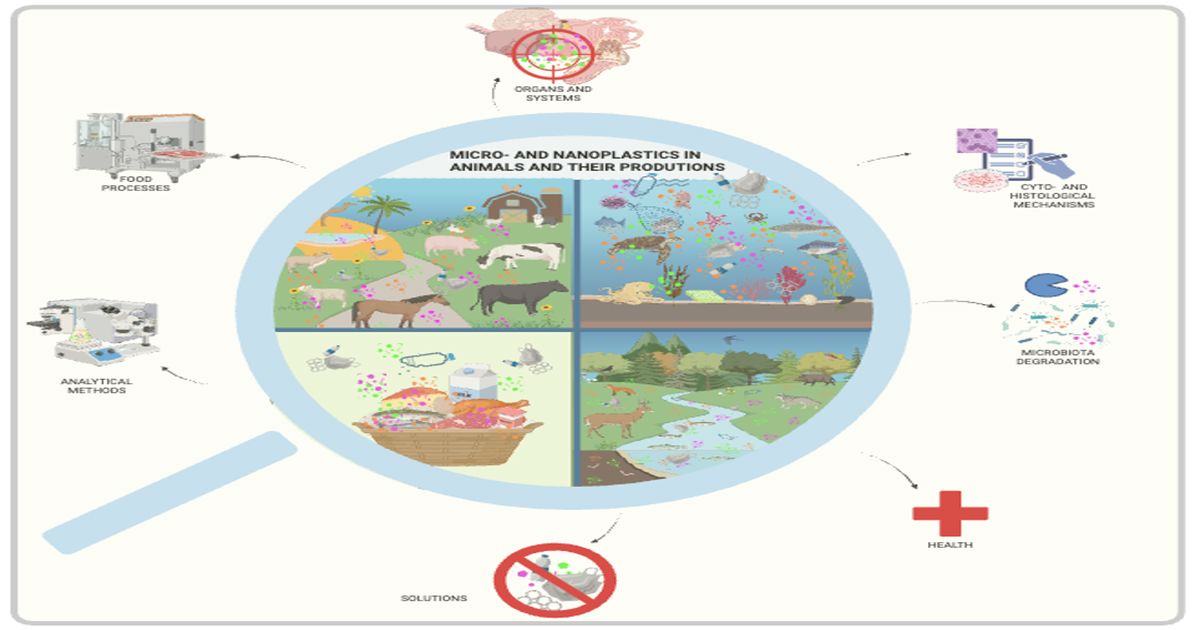Topic Editors




Micro- and Nanoplastics in Animals and Livestock Production

Topic Information
Dear Colleagues,
Nowadays, micro- and nanoplastics (MNPs) are ubiquitous in terrestrial and aquatic ecosystems. Their accumulation in farmed and wild animals—and along the entire feed-to-food chain—raises pressing concerns for animal welfare, food safety, and public health. This Topic invites original research articles and reviews that achieve the following:
- Map MNP contamination in animals, their environments, feeds, and derived products.
- Clarify biological interactions with MPs, including their absorption, translocation, accumulation, and their cytological, histopathological, physiological, and metabolic effects.
- Evaluate the impact of MNPs on animal productivity, reproduction, immune function, health, welfare, and animal-derived products.
- Investigate the interactions between MNPs and other contaminants (e.g., heavy metals, antibiotics, pesticides) within animal systems.
- Analyse the fate of MNPs during the processing of animal-derived products.
- Develop rapid and reliable detection methods for MNPs in complex biological matrices.
- Evaluate preventive and mitigative strategies, from improved husbandry and reduced plastic to digestive or microbial degradation pathways.
We particularly encourage studies that achieve the following:
- Quantify MNP loads in terrestrial and aquatic species, whether farmed or wild, across the feed-to-food chain.
- Propose simple, innovative measurement techniques applicable to feeds, animal tissues, organs, and products.
- Assess interventions to prevent or reduce MNP exposure in animals.
- Investigate the capacity of rumen or gut microbiota to break down MNPs and related polymers.
By integrating these multidisciplinary insights, this Topic aims to clarify contamination levels, reveal mechanisms of toxicity, and identify the most promising routes to safeguard both animal and human health.
Dr. Sonia Tassone
Prof. Dr. Beniamino T. Cenci-Goga
Dr. Samia Ben Said
Dr. Khalil Abid
Topic Editors
Keywords
- microplastics
- nanoplastics
- animals
- feed-to-food chain
- health
- detection methods
- mitigation strategies
- food safety
Participating Journals
| Journal Name | Impact Factor | CiteScore | Launched Year | First Decision (median) | APC | |
|---|---|---|---|---|---|---|

Fishes
|
2.4 | 3.0 | 2016 | 20.9 Days | CHF 2600 | Submit |

Foods
|
5.1 | 8.7 | 2012 | 14.9 Days | CHF 2900 | Submit |

Microplastics
|
5.1 | 6.8 | 2022 | 34.6 Days | CHF 1200 | Submit |

Veterinary Sciences
|
2.3 | 3.5 | 2014 | 21.1 Days | CHF 2100 | Submit |

Poultry
|
2.1 | 2.8 | 2022 | 34 Days | CHF 1200 | Submit |

Animals
|
2.7 | 5.2 | 2011 | 17.7 Days | CHF 2400 | Submit |

Ruminants
|
1.3 | 2.0 | 2021 | 18.4 Days | CHF 1200 | Submit |

Preprints.org is a multidisciplinary platform offering a preprint service designed to facilitate the early sharing of your research. It supports and empowers your research journey from the very beginning.
MDPI Topics is collaborating with Preprints.org and has established a direct connection between MDPI journals and the platform. Authors are encouraged to take advantage of this opportunity by posting their preprints at Preprints.org prior to publication:
- Share your research immediately: disseminate your ideas prior to publication and establish priority for your work.
- Safeguard your intellectual contribution: Protect your ideas with a time-stamped preprint that serves as proof of your research timeline.
- Boost visibility and impact: Increase the reach and influence of your research by making it accessible to a global audience.
- Gain early feedback: Receive valuable input and insights from peers before submitting to a journal.
- Ensure broad indexing: Web of Science (Preprint Citation Index), Google Scholar, Crossref, SHARE, PrePubMed, Scilit and Europe PMC.

